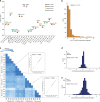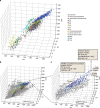Trapped ion mobility spectrometry and PASEF enable in-depth lipidomics from minimal sample amounts
- PMID: 31949144
- PMCID: PMC6965134
- DOI: 10.1038/s41467-019-14044-x
Trapped ion mobility spectrometry and PASEF enable in-depth lipidomics from minimal sample amounts
Abstract
A comprehensive characterization of the lipidome from limited starting material remains very challenging. Here we report a high-sensitivity lipidomics workflow based on nanoflow liquid chromatography and trapped ion mobility spectrometry (TIMS). Taking advantage of parallel accumulation-serial fragmentation (PASEF), we fragment on average 15 precursors in each of 100 ms TIMS scans, while maintaining the full mobility resolution of co-eluting isomers. The acquisition speed of over 100 Hz allows us to obtain MS/MS spectra of the vast majority of isotope patterns. Analyzing 1 µL of human plasma, PASEF increases the number of identified lipids more than three times over standard TIMS-MS/MS, achieving attomole sensitivity. Building on high intra- and inter-laboratory precision and accuracy of TIMS collisional cross sections (CCS), we compile 1856 lipid CCS values from plasma, liver and cancer cells. Our study establishes PASEF in lipid analysis and paves the way for sensitive, ion mobility-enhanced lipidomics in four dimensions.
Conflict of interest statement
The following authors state that they have potential conflicts of interest regarding this work: U.S.H., S.M., and A.B. are employees of Bruker, the manufacturer of the timsTOF Pro, and N.S.M. is employee of PREMIER Biosoft, the vendor of the SimLipid software. The other authors declare no competing interests.
Figures






Comment in
-
Reply to "Quality control requirements for the correct annotation of lipidomics data".Nat Commun. 2021 Aug 6;12(1):4772. doi: 10.1038/s41467-021-24985-x. Nat Commun. 2021. PMID: 34362889 Free PMC article. No abstract available.
-
Quality control requirements for the correct annotation of lipidomics data.Nat Commun. 2021 Aug 6;12(1):4771. doi: 10.1038/s41467-021-24984-y. Nat Commun. 2021. PMID: 34362906 Free PMC article. No abstract available.
References
Publication types
MeSH terms
Substances
LinkOut - more resources
Full Text Sources
Other Literature Sources

